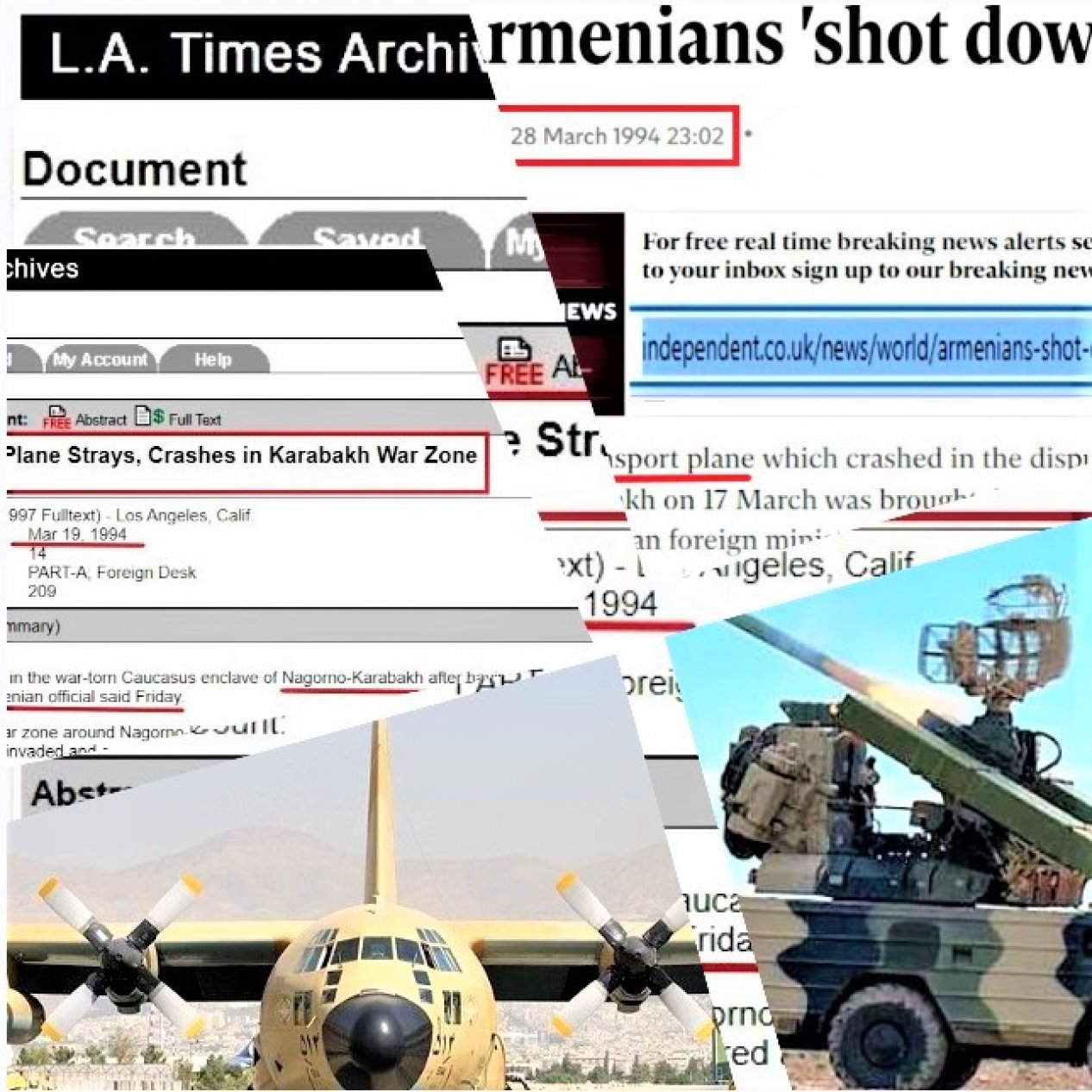
On March 17, 1994, an Iranian "Lockheed C-130 Hercules" plane was shot down over Khankandi by terrorist units in Nagorno-Karabakh. According to the media at that time, there were 13 crew members on the plane, as well as 19 family members (including 9 children) of the employees of the Iranian Embassy in Moscow. All the people on the plane who were going to their countries to celebrate Nowruz were killed.
According to the initial version, the plane had to fly over Russia, Georgia and Armenia and enter the airspace of Iran. But for some reason, it left the route and turned from Georgia to Azerbaijan, not to Armenia. On the territory of Azerbaijan (in the Karabakh region) active military operations were taking place. Military and diplomatic rules were not followed in the territories controlled by terrorist groups in the Karabakh region of Azerbaijan. For this reason, the terrorist units fired without specifying the aircraft entering the airspace under their control, thinking that it belonged to Azerbaijan. It turned out that the Lockheed C-130 Hercules passenger plane belonging to Iran was destroyed by an Osa surface-to-air missile.
Later it turned out that the pilot had sent a warning signal to the dispatcher that there were problems with the control. However, even though the units that committed the terrible terrorist incident realized that they made a mistake, they rejected this message and claimed that the plane crashed after hitting the ground.
Faktyoxla Lab. tried to clarify the issue by examining both Armenian and Iranian media reports regarding the incident.
First, we analyzed the news in the Armenian media.
In the Armenian media, the "Today in History" section of the 1or.am website mentions only this news:
“1994 — Iran's C-130 military transport plane carrying families of Iranian diplomats from Moscow to Tehran was shot down by Armenian armed forces near the city of Stepanakert, killing 19 passengers and 13 crew members.”

An article was published in the Armenian media under the title "The crash of the Iranian C-130 plane". In that information, it is mentioned that the Iranian "Lockheed C-130 Hercules" plane was shot down by the armed forces of Armenia. On March 17, 1994, a "C-130" passenger plane was shot down in the Aygistan settlement, located 10 kilometers from Khankandi, better known as Ballica. Family members of employees of the Iranian embassy in Moscow were on the plane. (Human Rights Watch/Helsinki, Christopher Panico, Jemera Rone. Azerbaijan: Seven years of conflict in Nagorno-Karabakh. Human Rights Watch, 1994. ISBN 1564321428, 9781564321428, p. 108)
This information was reflected in the articles published in the issues of March 19, 1994, and March 29, 1994, of The Independent newspaper, and in the issue of Kommersant newspaper dated 01.04.1994 No. 58 (526).
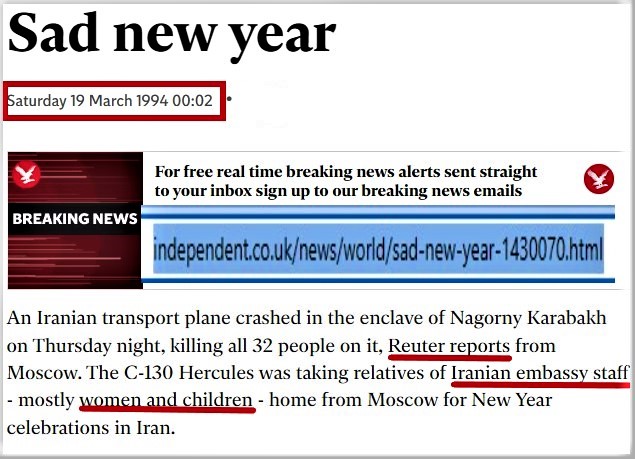
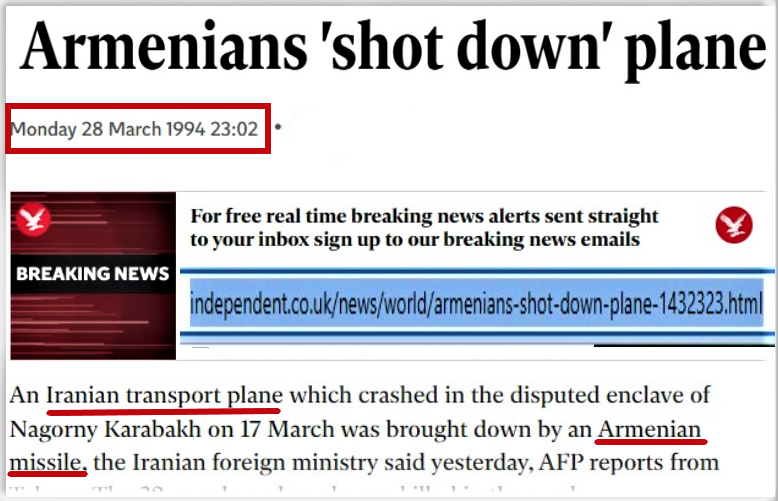
In these sources, there are notes that the plane entered the Nagorno-Karabakh airspace after deviating from its route and that the crew reported technical problems to the "local" operator. All sources say that despite the warning (the local radio receivers were controlled by terrorist groups), the plane crashed after a while.
At the press conference held in connection with the incident, Deputy Minister of Foreign Affairs of Armenia Jirayr Liparityan said that the plane should have passed through the airspaces of Russia, Georgia and Armenia and landed in Iran. However, the plane deviated from its route by about 100 kilometers and appeared in the territory of Azerbaijan, and then in the war zone - Nagorno-Karabakh. This was mentioned in the article published in the March 19, 1994 edition of the Los Angeles Times. (32 Die as Iranian Plane Strays, Crashes in Karabakh War Zone)
The Iranian embassy in Moscow announced that 19 passengers, including 9 children and 13 crew members, were killed as a result of the plane crash. The bodies of the dead Iranian citizens were taken to Armenia and sent to Tehran from Yerevan's Zvartnots International Airport. Vice President of the Republic of Armenia Gagik Harutyunyan and Deputy Prime Minister Vigen Chitechyan took part in the funeral ceremony.
A special committee was established in the Iranian Air Force to investigate the causes of the tragedy. The chairman of the committee, Abdat Aminian, denied the version of the vice president of the Republic of Armenia, Gagik Harutyunyan, that the plane lost control and crashed due to a malfunction of the control systems during the flight. The representative of the Ministry of Foreign Affairs of Iran stated that "the plane deviated from the route for unspecified reasons and later crashed into the ground. (Source: ИТАР-ТАСС, March 22, 1994. Remains of Iranians killed in Thursday crash sent to Iran).
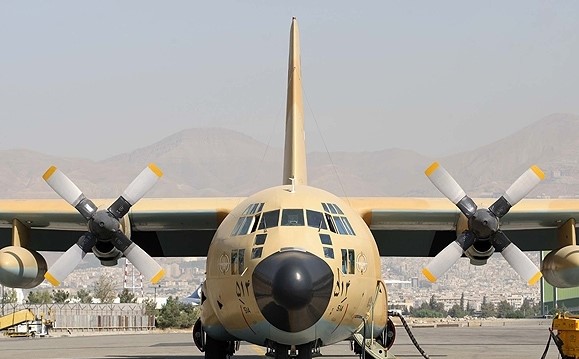
Stating that the plane was shot down by two rockets fired by the Armenian armed forces, Aminian noted that the Armenian side took responsibility for the plane crash. Aminian also said that the Armenian troops took the Iranian plane for an Azerbaijani plane and did not even try to contact the crew to find out who owned the aircraft. (Source: ITAR-TASS, March 31, 1994. Iranian C-130 plane was downed by two missiles)
In the official statement issued by the Ministry of Foreign Affairs of Iran, it is stated that all the blame for the destruction of the C-130 aircraft belonging to the Iranian Air Force is placed on the armed forces of Armenia. The statement said that "Iran reserves the right to apply to the court and receive compensation for the victims of the plane crash, and also calls on the Armenian leadership to identify and punish those responsible for the downing of the military plane." (Sources: Associated Press, March 28, 1994. Iran Says Armenian Forces Downed Airplane Killing 32. BBC, March 30, 1994. Foreign Ministry says Armenian troops shot down Iranian passenger aircraft).
The Ministry of National Security of Azerbaijan presented the audio recordings of the radio conversations conducted on the day of the plane crash to the Iranian side. The following sentence can be heard in the audio recording: "We just shot down an Azerbaijani military plane." (Source: Независимая газета, March 26, 1994. „We Just Downed Azeri Military Plane.“ Azeri Intelligence Holds Stepanakert Radioed Such A Message To Yerevan On Day Of Iranian C-130 Disaster). Azerbaijani intelligence believes that the military plane was shot down by the Osa anti-aircraft missile complex.
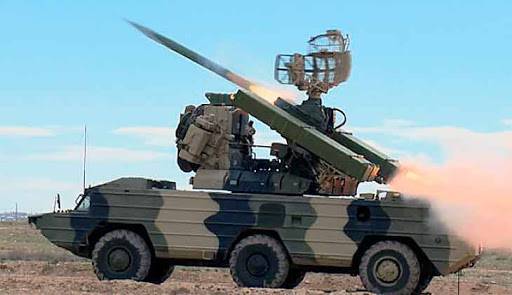
Some Russian experts believe that the Iranian plane deviated from its route to carry out a reconnaissance mission. (source: The Christian Science Monitor, March 22, 1994. Wendy Sloane. Crashed Iranian jet may have been spying). However, the Ministry of Foreign Affairs of Iran denied this hypothesis. (Source: ITAR-TASS, March 22, 1994. Iran rejects its crashed C-130 was spying).
Iranian President Ali Akbar Hashemi Rafsanjani, during his meeting with Armenian Vice President Gagik Harutyunyan in Tehran, demanded that all those involved in the downing of the military plane be punished. (Source: Associated Press, May 04, 1994. Iran Calls On Armenia To Expedite Plane Crash Investigation).
Before leaving Tehran, Harutyunyan admitted that the Iranian aircraft was downed "by mistake", but did not name the culprits. (Source: ITAR-TASS, May 5, 1994. Iranian plane was shot down over Karabakh «by mistake»)
Human Rights Watch stated: "According to the rules of war, the Armenian military units in Karabakh were obliged to check the passengers of the plane before opening fire." If they did not use the plane's identification tools, this is considered a gross violation of humanitarian law." (Source: Human Rights Watch/Helsinki, Christopher Panico, Jemera Rone. Azerbaijan: Seven years of conflict in Nagorno-Karabakh. Human Rights Watch, 1994. ISBN 1564321428, 9781564321428, p. 108)
This information was prepared with reference to the reports disseminated by Armenia and well-known international media at the time the plane was shot down.
Now let's pay attention to what the Iranian media wrote.
The investigation revealed the downing of the C-130 military transport plane carrying Iranian diplomats operating in Russia and family members in the airspace of Karabakh, more precisely, when Azerbaijan’s Khankandi was under the control of Armenian terrorists (on March 17, 1994), by the occupying Armenian troops is one of the most censored issues in Iran. So, during the past years, no press agency was allowed to write or speak on this topic and demand the punishment of the culprits. It is possible to find only few articles related to this issue in the Iranian official and semi-official press, which is subject to strict censorship.
Nevertheless, after many years of silence, on August 1, 2017, the Iranian plane shot down by the Armenians was discussed again during the presentation of a 70-minute Azerbaijani-language documentary film "Araz's Shallow Day" about the Karabakh war by Mohsen Hadi, a Tabriz cinematographer close to the Iranian regime.

The author's statement to the press about the presentation of the film, the articles published in the Fars news agency close to the Iranian Islamic Revolutionary Guard Corps (Sepah) and the official ISNA news agency shed light on many fakes. Of course, many may think that this film is about the misfortunes that Armenians have brought upon Azerbaijanis. But this is not so. The film is dedicated to false information about Iran's alleged assistance to Azerbaijan during the war, rather than the misfortunes Armenians have brought upon Azerbaijanis. With this, the propagandists of the mullah regime aimed to find supporters in the minds of the Azerbaijani people. From the presentation of the film, it became clear that Iran shows its true face here as well. So, in order to cover up the downing of the plane by the Armenians, it was stated that it was not shot by the Armenians, but only by one of the parties to the conflict. Nevertheless, the author Mohsen Hadi's comments in the interview about the filming of the film indicate the level of the Iranian cover-up of this terrorist act committed by Armenians. Thus, the author states that he had heard that Iranian citizens were "martyred" in the Karabakh war for many years. But actually, for the first time, he saw the inscription on the graves of 2 mothers and 2 children who died in Karabakh while visiting the graves of the people buried in the Ali Akbar shrine in Tehran. After that, Mohsen Hadi applied to the "Martyr Fund" in Iran, where the information of "martyrs" is kept, to get detailed information about the death of these people, but the fund gave him only the names of the dead people and the fact that they died in a "plane accident". In other words, this shows that the matter was falsified by the official institutions claiming that the plane was not shot down by Armenians, but crashed.
The author also repeated the disinformation that the plane lost its route due to weather conditions and entered Karabakh and became a "victim of the war", however, he stated that this issue was covered up in Iran, and the vast majority of the country's population was not aware of this incident.
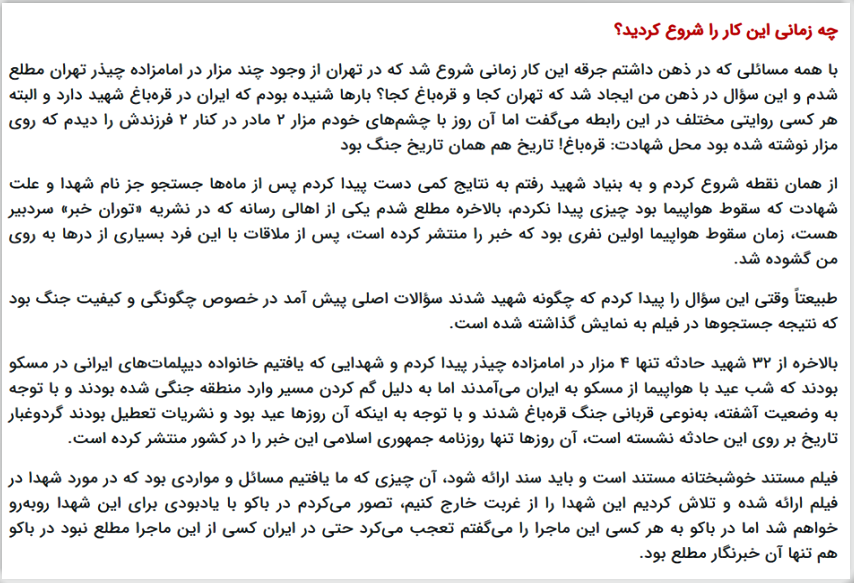
Despite the efforts of the Iranian government to falsify and forget the issue, on March 18, 2019, on the anniversary of the incident, the East Azerbaijan editorial office of the Fars news agency prepared an article with little information about the documentary film "Araz's Shallow Day". However, here the journalists stepped out of the censorship line and reported on the incident, stating that the plane was shot down by the Armenian army, and the reason for this was still unknown. In the article, it is also stated that in the first days of the incident, only the official "Islamic Republic" newspaper published a few reports, and after that, no information was given about the incident.
On October 15, 2020, during the Second Karabakh War, the topic was mentioned in an article with biased disinformation against Azerbaijan on the prestigious "Iran Diplomacy" portal of the Ministry of Foreign Affairs of Iran. The article admits that the Iranian plane was shot down by the aggressive Armenian army in 1994. However, this opinion was not given to condemn Armenian terrorism. In the article, it is instilled that the Second Karabakh War allegedly posed a threat to Iran, and in the previous sentence, the fact that the Armenians actually shot down the plane in the First Karabakh War was mentioned as damage to Iran. In fact, these were thoughts calculated to stop the Second Karabakh War.
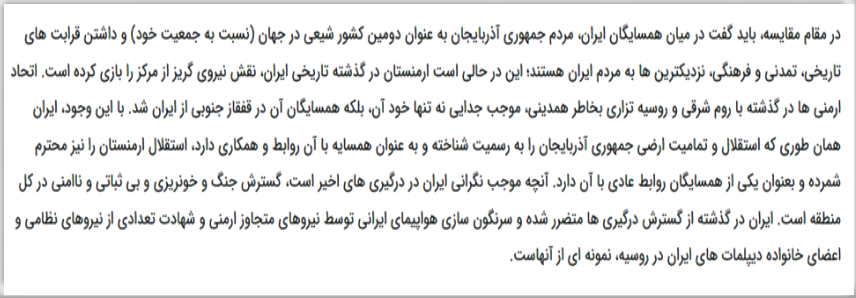
In an article published on the Iranian "Azeriha" website, which is part of the anti-Azerbaijani network, it was generally denied that the plane was shot down by Armenians, and speculations were circulated that it was shot down by Russia and Azerbaijan.
Shortly after the incident, neither the Iranian officials nor the country's media mentioned this topic again. However, in 1998, when 10 diplomats and 1 journalist working in its consulate in Mazar-i-Sharif were killed by the Taliban, Iran responded by concentrating 10,000 military forces and equipment on the border with Afghanistan and decided to go to war with the Taliban. The decision to attack was canceled at the last minute by Ali Khamenei. However, we have witnessed that Iran, which always prefers double standards, not only did not react to the death of its diplomats' family members and minors as a result of the terrorism committed by Armenians in 1994, but tried to make others forget this incident and gave even stronger support to Armenia. In other words, Iran, which did not react to this terror, tried to show muscle to Azerbaijan, which liberated its lands in the Second Karabakh War. After the war, Tehran conducted several military exercises on its borders with Azerbaijan, not the invading terrorists, and continues its provocations even today.
To sum up,
- It is true that on March 17, 1994, an Iranian passenger plane was shot down by Armenian terrorist groups in the Karabakh region of Azerbaijan.
- Although the Armenian media sees Petrosyan's government directly guilty of this incident, the Iranian government denies it and tries to make it forgotten on purpose.
- In the first days after the incident, Iran officially blamed Armenia, demanded the punishment of the involved persons and compensation, but later decided to turn a blind eye to the issue at the highest level for the sake of its insidious interests.




















